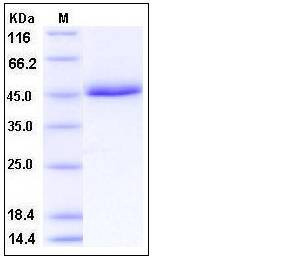Human CD5 Protein (His Tag)
LEU1,T1
- 100ug (NPP3701) Please inquiry
| Catalog Number | P11027-H08H |
|---|---|
| Organism Species | Human |
| Host | Human Cells |
| Synonyms | LEU1,T1 |
| Molecular Weight | The secreted recombinant human CD5 consists of 359 amino acids after removal of the signal peptide and has a calculated molecular mass of 40 kDa. In SDS-PAGE under reducing conditions, it migrates as an approximately 47 kDa band due to glycosylation. |
| predicted N | Arg 25 |
| SDS-PAGE |  |
| Purity | > 95 % as determined by SDS-PAGE |
| Protein Construction | A DNA sequence encoding the human CD5 (NP_055022.2) extracellular domain (Met 1-Pro 372) was expressed with a polyhistidine tag at the C-terminus. |
| Bio-activity | Measured by its ability to bind biotinylated recombinant human LCK in a functional ELISA. |
| Research Area | Immunology |Inflammation / Inflammatory Mediator |Cells Involved in Inflammation |Monocyte/Macrophage |
| Formulation | Lyophilized from sterile PBS, pH 7.4 1. Normally 5 % - 8 % trehalose, mannitol and 0.01% Tween80 are added as protectants before lyophilization. Specific concentrations are included in the hardcopy of COA. |
| Background | The cluster of differentiation (CD) system is commonly used as cell markers in immunophynotyping. Different kinds of cells in the immune system can be identified through the surface CD molecules which associating with the immune function of the cell. There are more than 320 CD unique clusters and subclusters have been identified. Some of the CD molecules serve as receptors or ligands important to the cell through initiating a signal cascade which then alter the behavior of the cell. Some CD proteins do not take part in cell signal process but have other functions such as cell adhesion. CD5 is a member of the CD system. CD5 was found to be widely distributed in T-cells and B1 cells which is a subset of IgM-secreting B cells. CD5 also was found expressed in small lymphocytic lymphoma, hairy cell leukaemia and mantle cell lymphoma cells. CD5 serves to weaken the activating stimulus from the BCR so that the B1 cells can only reflect to the very strong stimuli but not the normal tissue proteins. |
| Reference |
